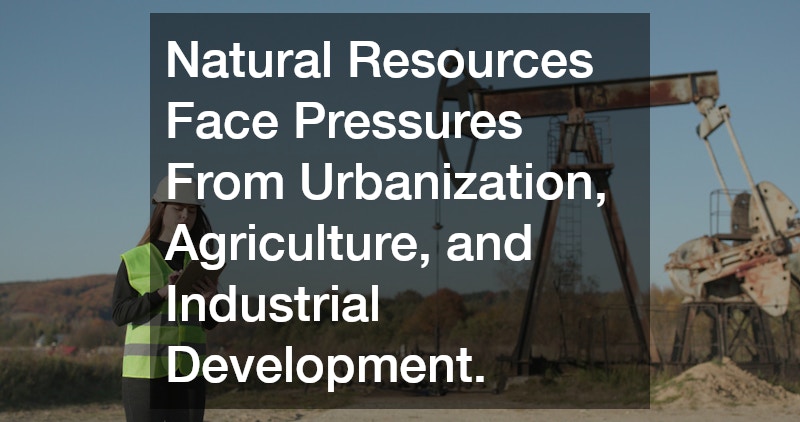Proper land use planning plays a vital role in safeguarding natural resources. By implementing sustainable land use strategies, communities can ensure that land is used efficiently and beneficially for both humans and the environment. Sustainable land use involves managing land resources to meet current needs while preserving natural ecosystems for future generations.
Natural resources face significant pressures from urbanization, agriculture, and industrial development. When land is not managed sustainably, ecosystems can be degraded, leading to the loss of biodiversity and natural habitats.
This can also result in negative impacts on air and water quality, contributing to climate change and soil erosion.
The implementation of sustainable land use practices offers a multitude of benefits. By prioritizing ecological balance, these practices help maintain biodiversity, enhance ecosystem services, and improve the resilience of natural systems against external shocks. Additionally, sustainable land use can support economic activities, like agriculture and tourism, by preserving the landscapes and resources essential to these industries.
The Role of Urban Planning in Land Use Management
Urban planning is a critical component of sustainable land use. It involves guiding the development of land in and around urban areas to optimize resource use while minimizing environmental impact. Effective urban planning can lead to well-organized cities where natural resources are preserved and efficiently utilized.
One key aspect of urban planning is zoning, which designates specific land areas for residential, commercial, or industrial purposes. By controlling land use patterns through zoning laws, cities can curb urban sprawl and protect green spaces and natural habitats. This reduces the encroachment on forests and wetlands, preserving these crucial ecosystems.
Urban planning also includes the development of green infrastructure, such as parks and green belts, which provide recreational spaces for residents while enhancing urban ecosystems. Green infrastructure helps regulate climate, supports biodiversity, and improves air and water quality, demonstrating that innovative planning can harmonize urban development with nature conservation.
Agricultural Practices and Their Impact on Natural Resources
Agriculture is a major land consumer and significantly affects natural resources. Unsustainable farming practices, such as overgrazing and monoculture, can deplete soil resources, pollute water supplies, and disrupt local ecosystems. To mitigate these impacts, sustainable land use practices in agriculture are essential.
Crop rotation and agroforestry are examples of sustainable agricultural practices that promote soil health and enhance biodiversity. Crop rotation helps prevent soil depletion by varying the types of plants grown, while agroforestry integrates trees with crops and livestock, creating more diverse and resilient ecosystems. These practices help maintain the natural resource base essential for long-term agricultural productivity.
Water management is another critical factor in sustainable agriculture. Techniques such as drip irrigation and rainwater harvesting can increase water use efficiency, reducing the strain on local water resources. By adopting these methods, farmers can sustainably manage their land and water resources, ensuring the longevity of both agricultural outputs and the environment.
Conservation Efforts and Policy Measures
Conservation efforts and policy measures are crucial in promoting sustainable land use. Governments and organizations around the world are increasingly recognizing the importance of preserving natural resources through legislative frameworks and conservation programs. These measures aim to protect biodiversity, sustain ecosystem services, and ensure the responsible use of land.
The establishment of protected areas and wildlife sanctuaries is a testament to these conservation efforts. These areas serve as havens for wildlife and natural habitats, effectively curbing habitat destruction and species extinction. Legislation, such as coastal zone management and forest conservation acts, also plays a pivotal role in regulating land use to safeguard natural resources.
International cooperation and agreements, such as the Convention on Biological Diversity, encourage countries to adopt policies promoting sustainable land use. These agreements provide a platform for sharing knowledge and resources, fostering collaboration in the conservation of natural resources globally. By working together, nations can develop effective strategies to balance development and conservation efforts.
The Community’s Role in Sustainable Land Use
Communities play an essential role in promoting sustainable land use. Local involvement in land use planning ensures that the needs and concerns of residents are addressed, leading to more effective and equitable outcomes. Community-based approaches empower individuals to take part in preserving their local environments.
Public awareness and education campaigns are crucial for encouraging sustainable practices. When communities are informed about the benefits of sustainable land use, they are more likely to support and participate in conservation efforts. This collective action can lead to significant improvements in land management and the protection of natural resources.
Community initiatives, such as local conservation projects and sustainable agriculture programs, serve as models for effective land use practices. These grassroots efforts demonstrate the power of community engagement in managing natural resources sustainably. By fostering a sense of responsibility and stewardship, communities can contribute significantly to the global effort of preserving our planet’s resources.



